HRD Report: Analysis of Learning Styles and Training at M&S
VerifiedAdded on 2020/06/04
|24
|6290
|196
Report
AI Summary
This report provides a comprehensive analysis of human resource development (HRD) practices at Marks & Spencer (M&S). It begins by comparing different learning styles, including Kolb's and Honey & Mumford's models, and discusses their relevance to M&S employees. The report then explores the role of the learning curve and the significance of transferring learning, examining individual and organizational learning. It also delves into the contribution of learning curve and various learning theories, such as behaviorism, cognitivism, and constructivism, in planning and designing effective learning events. Furthermore, the report assesses training needs at different organizational levels, evaluating the advantages and disadvantages of different training methods, and proposes a systematic approach to training and development. It also covers evaluation techniques using sustainable methods, and the success of evaluation methods. Finally, it examines the role of government in training, development, and lifelong learning, and the impact of competency movements on public and private sectors, including contemporary training initiatives by the UK Government. The report concludes with a summary of key findings and recommendations for improving HRD practices at M&S.
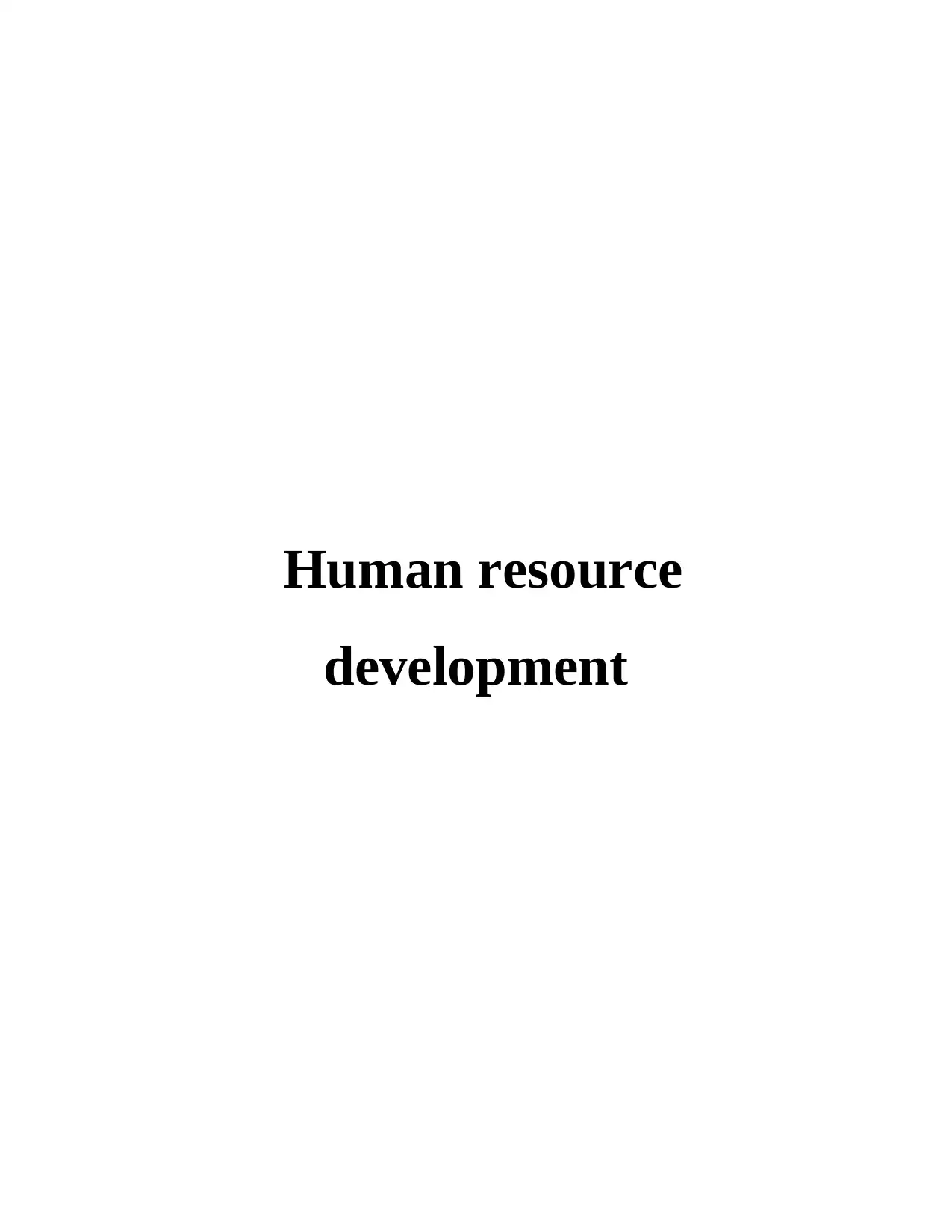
Human resource
development
development
Paraphrase This Document
Need a fresh take? Get an instant paraphrase of this document with our AI Paraphraser
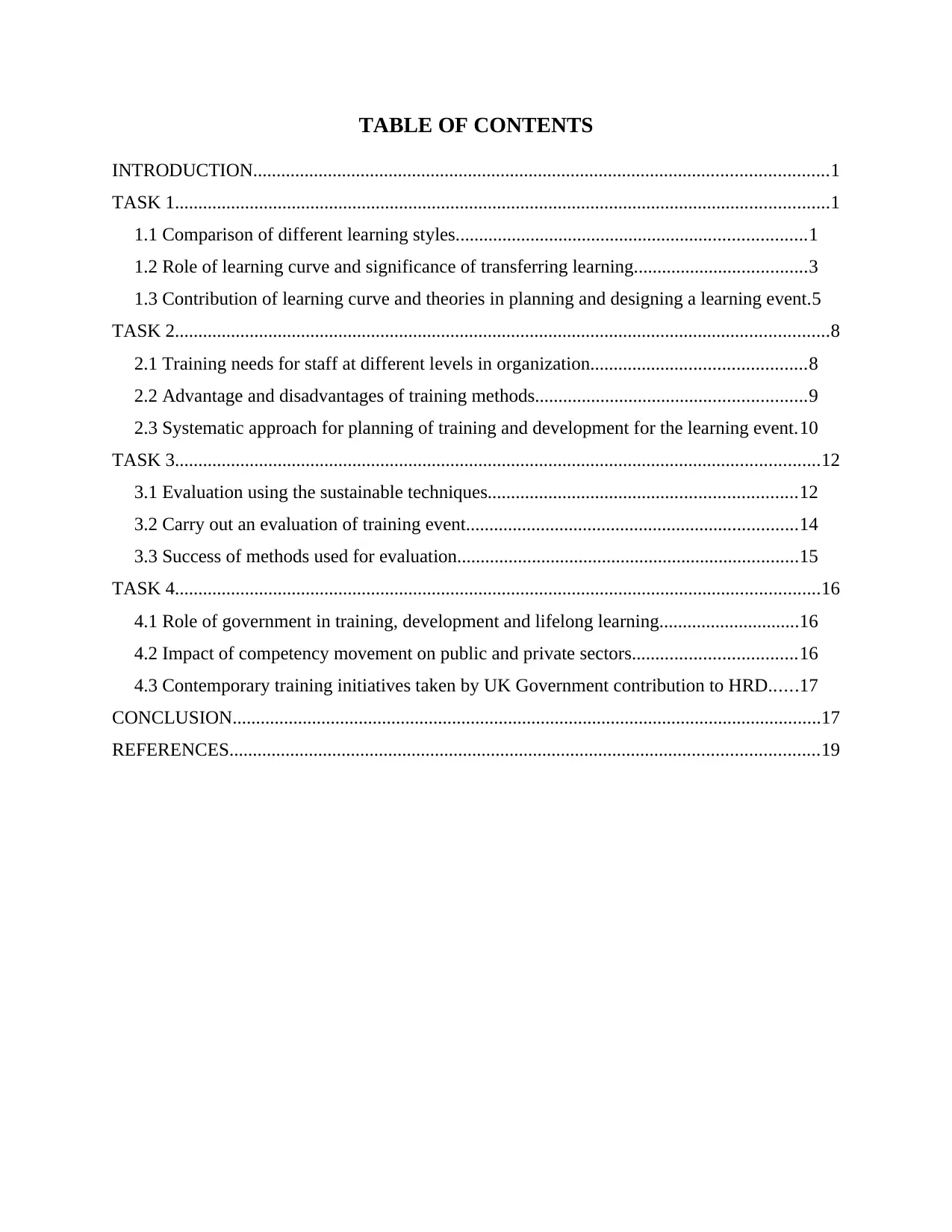
TABLE OF CONTENTS
INTRODUCTION...........................................................................................................................1
TASK 1............................................................................................................................................1
1.1 Comparison of different learning styles...........................................................................1
1.2 Role of learning curve and significance of transferring learning.....................................3
1.3 Contribution of learning curve and theories in planning and designing a learning event.5
TASK 2............................................................................................................................................8
2.1 Training needs for staff at different levels in organization..............................................8
2.2 Advantage and disadvantages of training methods..........................................................9
2.3 Systematic approach for planning of training and development for the learning event.10
TASK 3..........................................................................................................................................12
3.1 Evaluation using the sustainable techniques..................................................................12
3.2 Carry out an evaluation of training event.......................................................................14
3.3 Success of methods used for evaluation.........................................................................15
TASK 4..........................................................................................................................................16
4.1 Role of government in training, development and lifelong learning..............................16
4.2 Impact of competency movement on public and private sectors...................................16
4.3 Contemporary training initiatives taken by UK Government contribution to HRD......17
CONCLUSION..............................................................................................................................17
REFERENCES..............................................................................................................................19
INTRODUCTION...........................................................................................................................1
TASK 1............................................................................................................................................1
1.1 Comparison of different learning styles...........................................................................1
1.2 Role of learning curve and significance of transferring learning.....................................3
1.3 Contribution of learning curve and theories in planning and designing a learning event.5
TASK 2............................................................................................................................................8
2.1 Training needs for staff at different levels in organization..............................................8
2.2 Advantage and disadvantages of training methods..........................................................9
2.3 Systematic approach for planning of training and development for the learning event.10
TASK 3..........................................................................................................................................12
3.1 Evaluation using the sustainable techniques..................................................................12
3.2 Carry out an evaluation of training event.......................................................................14
3.3 Success of methods used for evaluation.........................................................................15
TASK 4..........................................................................................................................................16
4.1 Role of government in training, development and lifelong learning..............................16
4.2 Impact of competency movement on public and private sectors...................................16
4.3 Contemporary training initiatives taken by UK Government contribution to HRD......17
CONCLUSION..............................................................................................................................17
REFERENCES..............................................................................................................................19
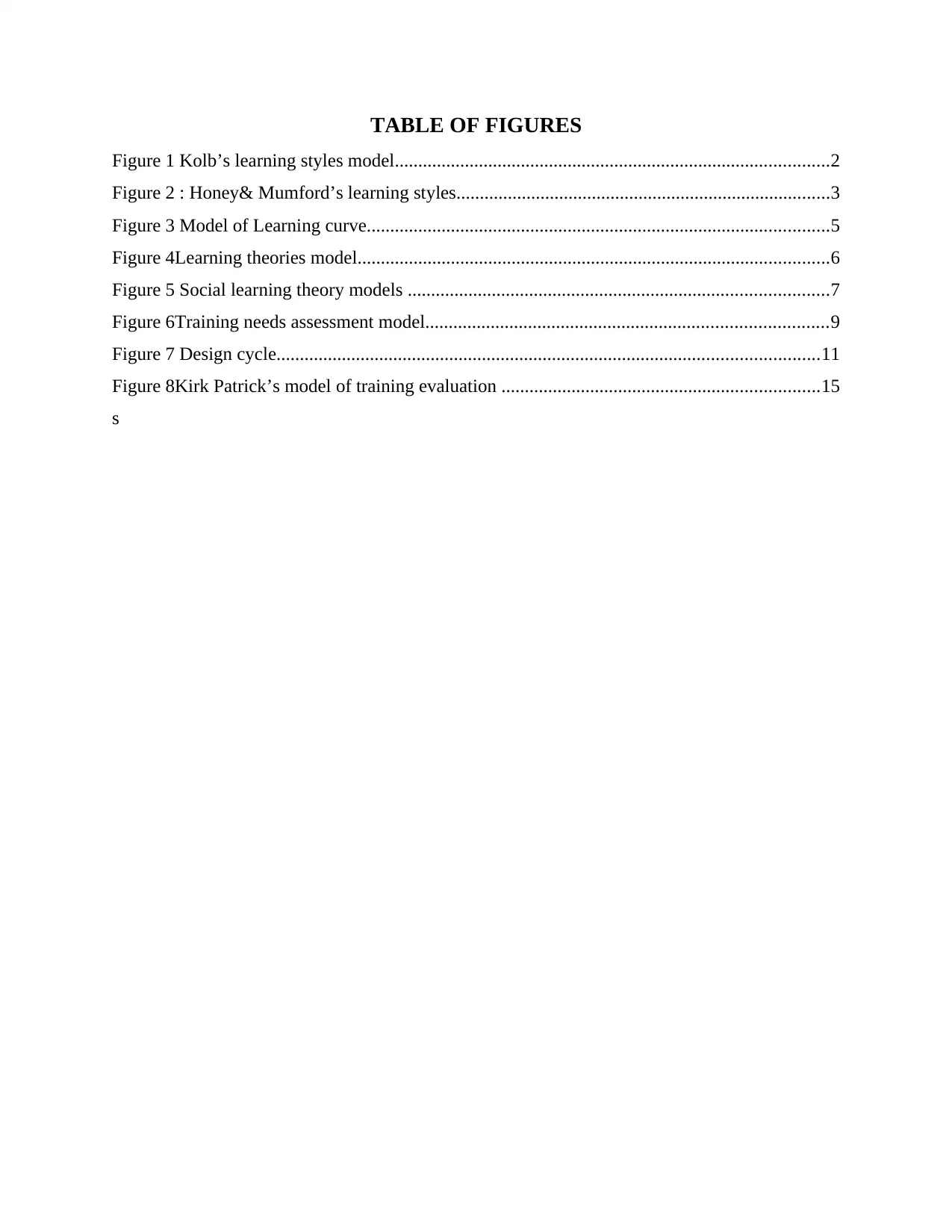
TABLE OF FIGURES
Figure 1 Kolb’s learning styles model.............................................................................................2
Figure 2 : Honey& Mumford’s learning styles................................................................................3
Figure 3 Model of Learning curve...................................................................................................5
Figure 4Learning theories model.....................................................................................................6
Figure 5 Social learning theory models ..........................................................................................7
Figure 6Training needs assessment model......................................................................................9
Figure 7 Design cycle....................................................................................................................11
Figure 8Kirk Patrick’s model of training evaluation ....................................................................15
s
Figure 1 Kolb’s learning styles model.............................................................................................2
Figure 2 : Honey& Mumford’s learning styles................................................................................3
Figure 3 Model of Learning curve...................................................................................................5
Figure 4Learning theories model.....................................................................................................6
Figure 5 Social learning theory models ..........................................................................................7
Figure 6Training needs assessment model......................................................................................9
Figure 7 Design cycle....................................................................................................................11
Figure 8Kirk Patrick’s model of training evaluation ....................................................................15
s
⊘ This is a preview!⊘
Do you want full access?
Subscribe today to unlock all pages.

Trusted by 1+ million students worldwide
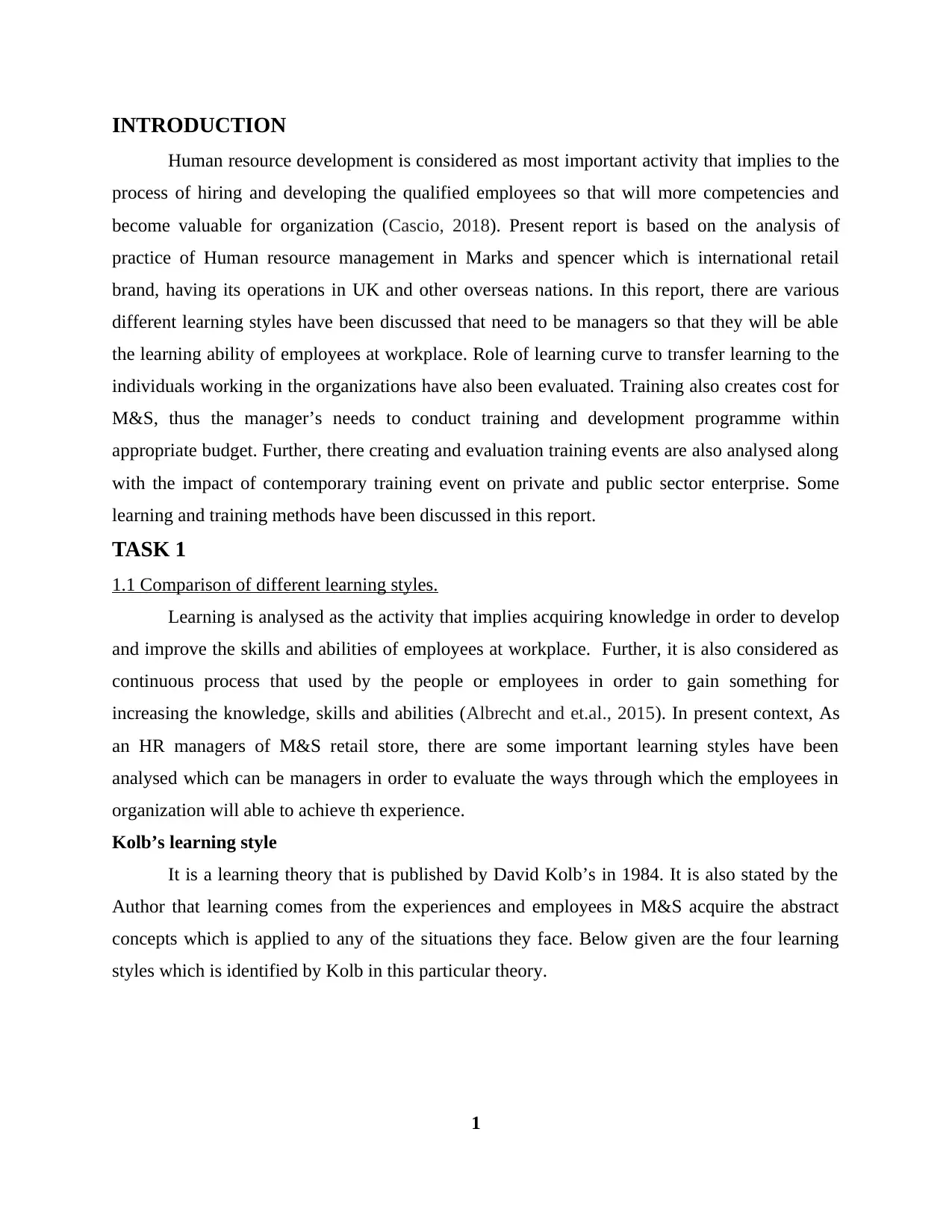
INTRODUCTION
Human resource development is considered as most important activity that implies to the
process of hiring and developing the qualified employees so that will more competencies and
become valuable for organization (Cascio, 2018). Present report is based on the analysis of
practice of Human resource management in Marks and spencer which is international retail
brand, having its operations in UK and other overseas nations. In this report, there are various
different learning styles have been discussed that need to be managers so that they will be able
the learning ability of employees at workplace. Role of learning curve to transfer learning to the
individuals working in the organizations have also been evaluated. Training also creates cost for
M&S, thus the manager’s needs to conduct training and development programme within
appropriate budget. Further, there creating and evaluation training events are also analysed along
with the impact of contemporary training event on private and public sector enterprise. Some
learning and training methods have been discussed in this report.
TASK 1
1.1 Comparison of different learning styles.
Learning is analysed as the activity that implies acquiring knowledge in order to develop
and improve the skills and abilities of employees at workplace. Further, it is also considered as
continuous process that used by the people or employees in order to gain something for
increasing the knowledge, skills and abilities (Albrecht and et.al., 2015). In present context, As
an HR managers of M&S retail store, there are some important learning styles have been
analysed which can be managers in order to evaluate the ways through which the employees in
organization will able to achieve th experience.
Kolb’s learning style
It is a learning theory that is published by David Kolb’s in 1984. It is also stated by the
Author that learning comes from the experiences and employees in M&S acquire the abstract
concepts which is applied to any of the situations they face. Below given are the four learning
styles which is identified by Kolb in this particular theory.
1
Human resource development is considered as most important activity that implies to the
process of hiring and developing the qualified employees so that will more competencies and
become valuable for organization (Cascio, 2018). Present report is based on the analysis of
practice of Human resource management in Marks and spencer which is international retail
brand, having its operations in UK and other overseas nations. In this report, there are various
different learning styles have been discussed that need to be managers so that they will be able
the learning ability of employees at workplace. Role of learning curve to transfer learning to the
individuals working in the organizations have also been evaluated. Training also creates cost for
M&S, thus the manager’s needs to conduct training and development programme within
appropriate budget. Further, there creating and evaluation training events are also analysed along
with the impact of contemporary training event on private and public sector enterprise. Some
learning and training methods have been discussed in this report.
TASK 1
1.1 Comparison of different learning styles.
Learning is analysed as the activity that implies acquiring knowledge in order to develop
and improve the skills and abilities of employees at workplace. Further, it is also considered as
continuous process that used by the people or employees in order to gain something for
increasing the knowledge, skills and abilities (Albrecht and et.al., 2015). In present context, As
an HR managers of M&S retail store, there are some important learning styles have been
analysed which can be managers in order to evaluate the ways through which the employees in
organization will able to achieve th experience.
Kolb’s learning style
It is a learning theory that is published by David Kolb’s in 1984. It is also stated by the
Author that learning comes from the experiences and employees in M&S acquire the abstract
concepts which is applied to any of the situations they face. Below given are the four learning
styles which is identified by Kolb in this particular theory.
1
Paraphrase This Document
Need a fresh take? Get an instant paraphrase of this document with our AI Paraphraser
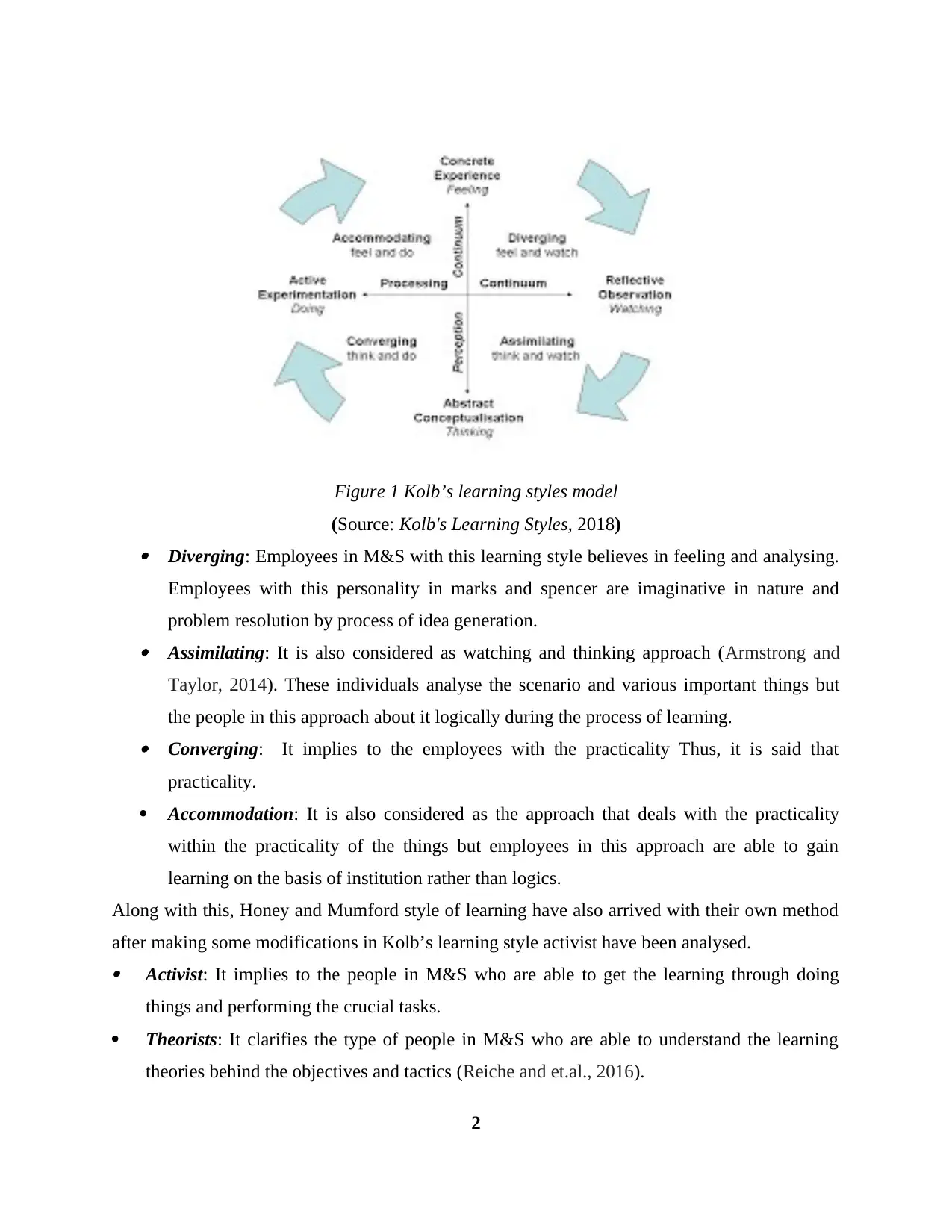
Figure 1 Kolb’s learning styles model
(Source: Kolb's Learning Styles, 2018) Diverging: Employees in M&S with this learning style believes in feeling and analysing.
Employees with this personality in marks and spencer are imaginative in nature and
problem resolution by process of idea generation. Assimilating: It is also considered as watching and thinking approach (Armstrong and
Taylor, 2014). These individuals analyse the scenario and various important things but
the people in this approach about it logically during the process of learning. Converging: It implies to the employees with the practicality Thus, it is said that
practicality.
Accommodation: It is also considered as the approach that deals with the practicality
within the practicality of the things but employees in this approach are able to gain
learning on the basis of institution rather than logics.
Along with this, Honey and Mumford style of learning have also arrived with their own method
after making some modifications in Kolb’s learning style activist have been analysed. Activist: It implies to the people in M&S who are able to get the learning through doing
things and performing the crucial tasks.
Theorists: It clarifies the type of people in M&S who are able to understand the learning
theories behind the objectives and tactics (Reiche and et.al., 2016).
2
(Source: Kolb's Learning Styles, 2018) Diverging: Employees in M&S with this learning style believes in feeling and analysing.
Employees with this personality in marks and spencer are imaginative in nature and
problem resolution by process of idea generation. Assimilating: It is also considered as watching and thinking approach (Armstrong and
Taylor, 2014). These individuals analyse the scenario and various important things but
the people in this approach about it logically during the process of learning. Converging: It implies to the employees with the practicality Thus, it is said that
practicality.
Accommodation: It is also considered as the approach that deals with the practicality
within the practicality of the things but employees in this approach are able to gain
learning on the basis of institution rather than logics.
Along with this, Honey and Mumford style of learning have also arrived with their own method
after making some modifications in Kolb’s learning style activist have been analysed. Activist: It implies to the people in M&S who are able to get the learning through doing
things and performing the crucial tasks.
Theorists: It clarifies the type of people in M&S who are able to understand the learning
theories behind the objectives and tactics (Reiche and et.al., 2016).
2
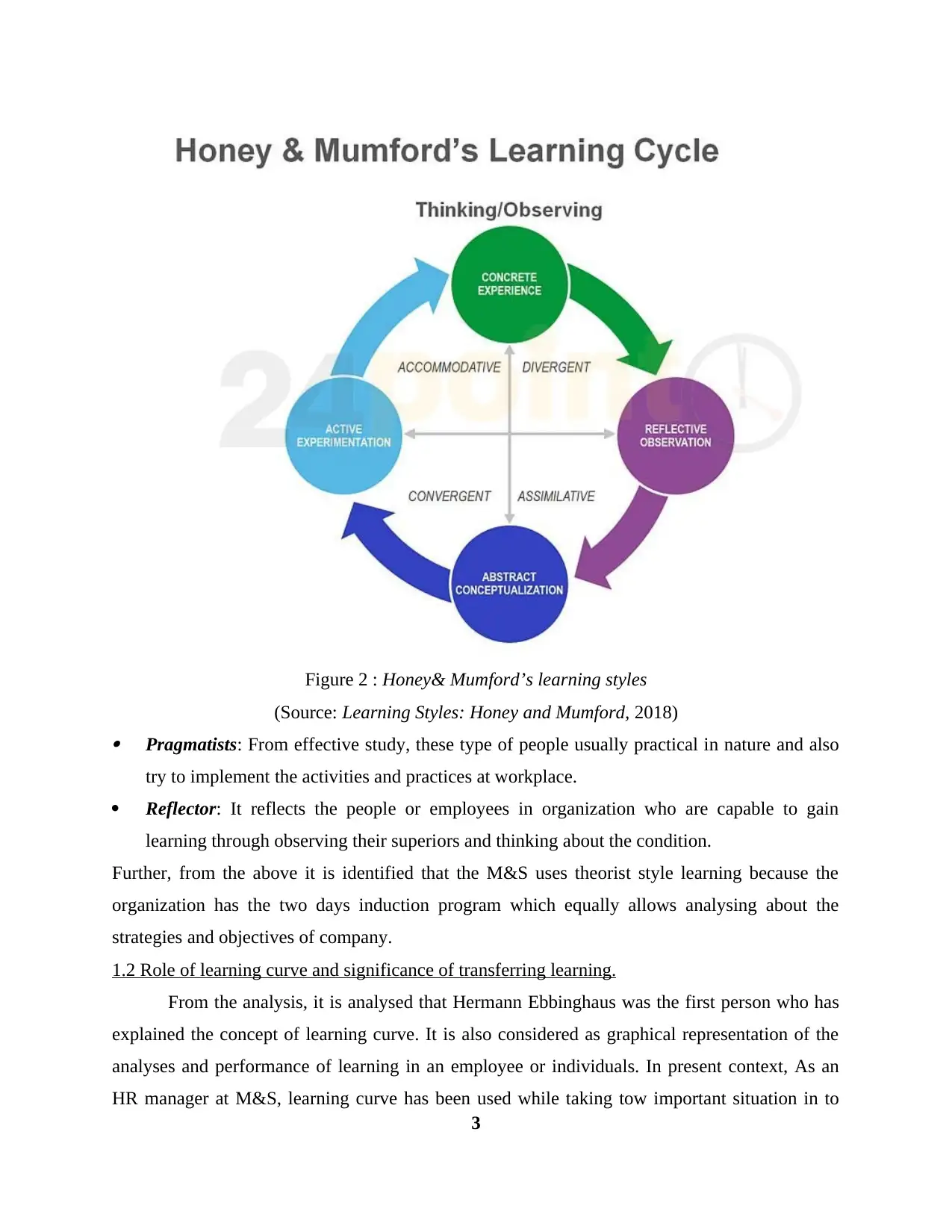
Figure 2 : Honey& Mumford’s learning styles
(Source: Learning Styles: Honey and Mumford, 2018) Pragmatists: From effective study, these type of people usually practical in nature and also
try to implement the activities and practices at workplace.
Reflector: It reflects the people or employees in organization who are capable to gain
learning through observing their superiors and thinking about the condition.
Further, from the above it is identified that the M&S uses theorist style learning because the
organization has the two days induction program which equally allows analysing about the
strategies and objectives of company.
1.2 Role of learning curve and significance of transferring learning.
From the analysis, it is analysed that Hermann Ebbinghaus was the first person who has
explained the concept of learning curve. It is also considered as graphical representation of the
analyses and performance of learning in an employee or individuals. In present context, As an
HR manager at M&S, learning curve has been used while taking tow important situation in to
3
(Source: Learning Styles: Honey and Mumford, 2018) Pragmatists: From effective study, these type of people usually practical in nature and also
try to implement the activities and practices at workplace.
Reflector: It reflects the people or employees in organization who are capable to gain
learning through observing their superiors and thinking about the condition.
Further, from the above it is identified that the M&S uses theorist style learning because the
organization has the two days induction program which equally allows analysing about the
strategies and objectives of company.
1.2 Role of learning curve and significance of transferring learning.
From the analysis, it is analysed that Hermann Ebbinghaus was the first person who has
explained the concept of learning curve. It is also considered as graphical representation of the
analyses and performance of learning in an employee or individuals. In present context, As an
HR manager at M&S, learning curve has been used while taking tow important situation in to
3
⊘ This is a preview!⊘
Do you want full access?
Subscribe today to unlock all pages.

Trusted by 1+ million students worldwide
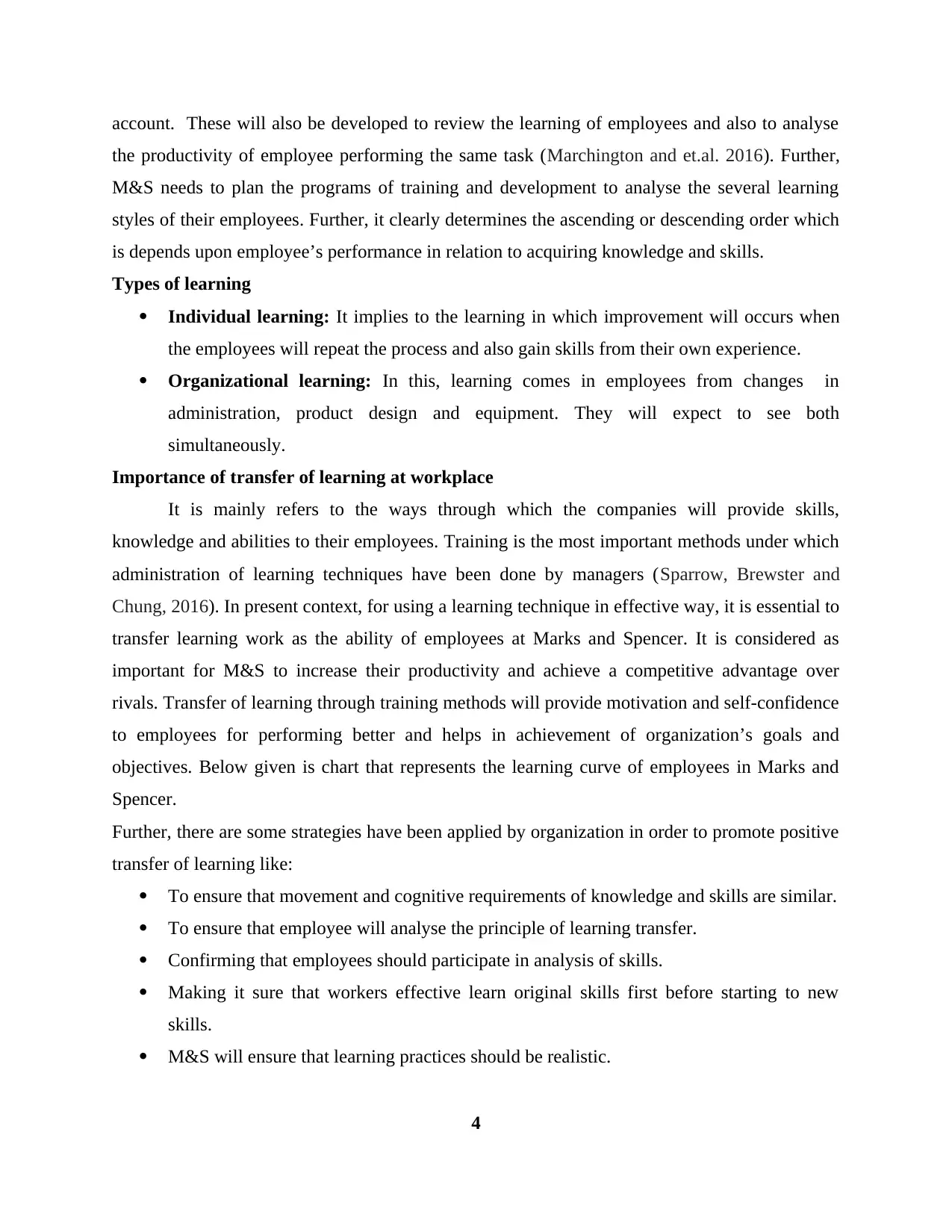
account. These will also be developed to review the learning of employees and also to analyse
the productivity of employee performing the same task (Marchington and et.al. 2016). Further,
M&S needs to plan the programs of training and development to analyse the several learning
styles of their employees. Further, it clearly determines the ascending or descending order which
is depends upon employee’s performance in relation to acquiring knowledge and skills.
Types of learning
Individual learning: It implies to the learning in which improvement will occurs when
the employees will repeat the process and also gain skills from their own experience.
Organizational learning: In this, learning comes in employees from changes in
administration, product design and equipment. They will expect to see both
simultaneously.
Importance of transfer of learning at workplace
It is mainly refers to the ways through which the companies will provide skills,
knowledge and abilities to their employees. Training is the most important methods under which
administration of learning techniques have been done by managers (Sparrow, Brewster and
Chung, 2016). In present context, for using a learning technique in effective way, it is essential to
transfer learning work as the ability of employees at Marks and Spencer. It is considered as
important for M&S to increase their productivity and achieve a competitive advantage over
rivals. Transfer of learning through training methods will provide motivation and self-confidence
to employees for performing better and helps in achievement of organization’s goals and
objectives. Below given is chart that represents the learning curve of employees in Marks and
Spencer.
Further, there are some strategies have been applied by organization in order to promote positive
transfer of learning like:
To ensure that movement and cognitive requirements of knowledge and skills are similar.
To ensure that employee will analyse the principle of learning transfer.
Confirming that employees should participate in analysis of skills.
Making it sure that workers effective learn original skills first before starting to new
skills.
M&S will ensure that learning practices should be realistic.
4
the productivity of employee performing the same task (Marchington and et.al. 2016). Further,
M&S needs to plan the programs of training and development to analyse the several learning
styles of their employees. Further, it clearly determines the ascending or descending order which
is depends upon employee’s performance in relation to acquiring knowledge and skills.
Types of learning
Individual learning: It implies to the learning in which improvement will occurs when
the employees will repeat the process and also gain skills from their own experience.
Organizational learning: In this, learning comes in employees from changes in
administration, product design and equipment. They will expect to see both
simultaneously.
Importance of transfer of learning at workplace
It is mainly refers to the ways through which the companies will provide skills,
knowledge and abilities to their employees. Training is the most important methods under which
administration of learning techniques have been done by managers (Sparrow, Brewster and
Chung, 2016). In present context, for using a learning technique in effective way, it is essential to
transfer learning work as the ability of employees at Marks and Spencer. It is considered as
important for M&S to increase their productivity and achieve a competitive advantage over
rivals. Transfer of learning through training methods will provide motivation and self-confidence
to employees for performing better and helps in achievement of organization’s goals and
objectives. Below given is chart that represents the learning curve of employees in Marks and
Spencer.
Further, there are some strategies have been applied by organization in order to promote positive
transfer of learning like:
To ensure that movement and cognitive requirements of knowledge and skills are similar.
To ensure that employee will analyse the principle of learning transfer.
Confirming that employees should participate in analysis of skills.
Making it sure that workers effective learn original skills first before starting to new
skills.
M&S will ensure that learning practices should be realistic.
4
Paraphrase This Document
Need a fresh take? Get an instant paraphrase of this document with our AI Paraphraser
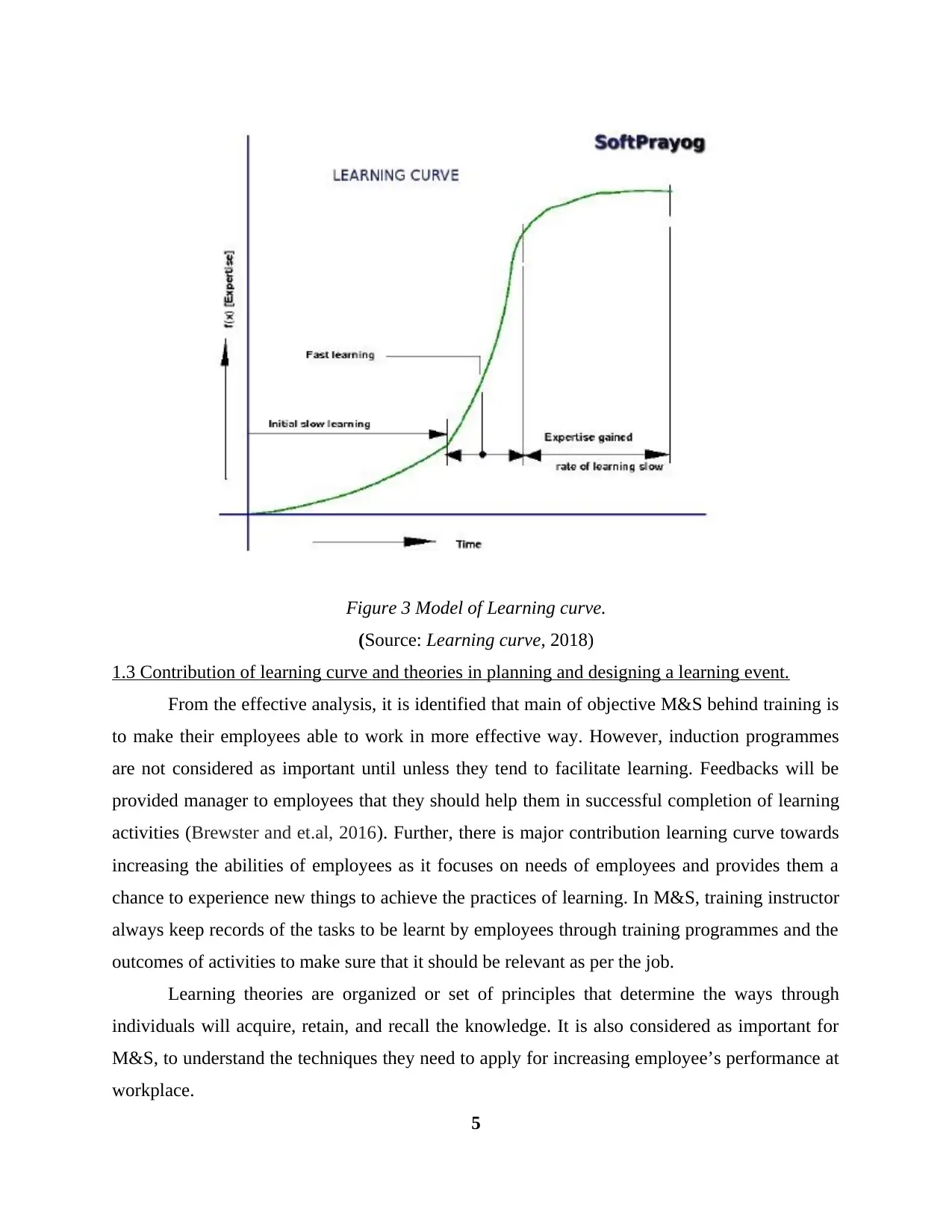
Figure 3 Model of Learning curve.
(Source: Learning curve, 2018)
1.3 Contribution of learning curve and theories in planning and designing a learning event.
From the effective analysis, it is identified that main of objective M&S behind training is
to make their employees able to work in more effective way. However, induction programmes
are not considered as important until unless they tend to facilitate learning. Feedbacks will be
provided manager to employees that they should help them in successful completion of learning
activities (Brewster and et.al, 2016). Further, there is major contribution learning curve towards
increasing the abilities of employees as it focuses on needs of employees and provides them a
chance to experience new things to achieve the practices of learning. In M&S, training instructor
always keep records of the tasks to be learnt by employees through training programmes and the
outcomes of activities to make sure that it should be relevant as per the job.
Learning theories are organized or set of principles that determine the ways through
individuals will acquire, retain, and recall the knowledge. It is also considered as important for
M&S, to understand the techniques they need to apply for increasing employee’s performance at
workplace.
5
(Source: Learning curve, 2018)
1.3 Contribution of learning curve and theories in planning and designing a learning event.
From the effective analysis, it is identified that main of objective M&S behind training is
to make their employees able to work in more effective way. However, induction programmes
are not considered as important until unless they tend to facilitate learning. Feedbacks will be
provided manager to employees that they should help them in successful completion of learning
activities (Brewster and et.al, 2016). Further, there is major contribution learning curve towards
increasing the abilities of employees as it focuses on needs of employees and provides them a
chance to experience new things to achieve the practices of learning. In M&S, training instructor
always keep records of the tasks to be learnt by employees through training programmes and the
outcomes of activities to make sure that it should be relevant as per the job.
Learning theories are organized or set of principles that determine the ways through
individuals will acquire, retain, and recall the knowledge. It is also considered as important for
M&S, to understand the techniques they need to apply for increasing employee’s performance at
workplace.
5
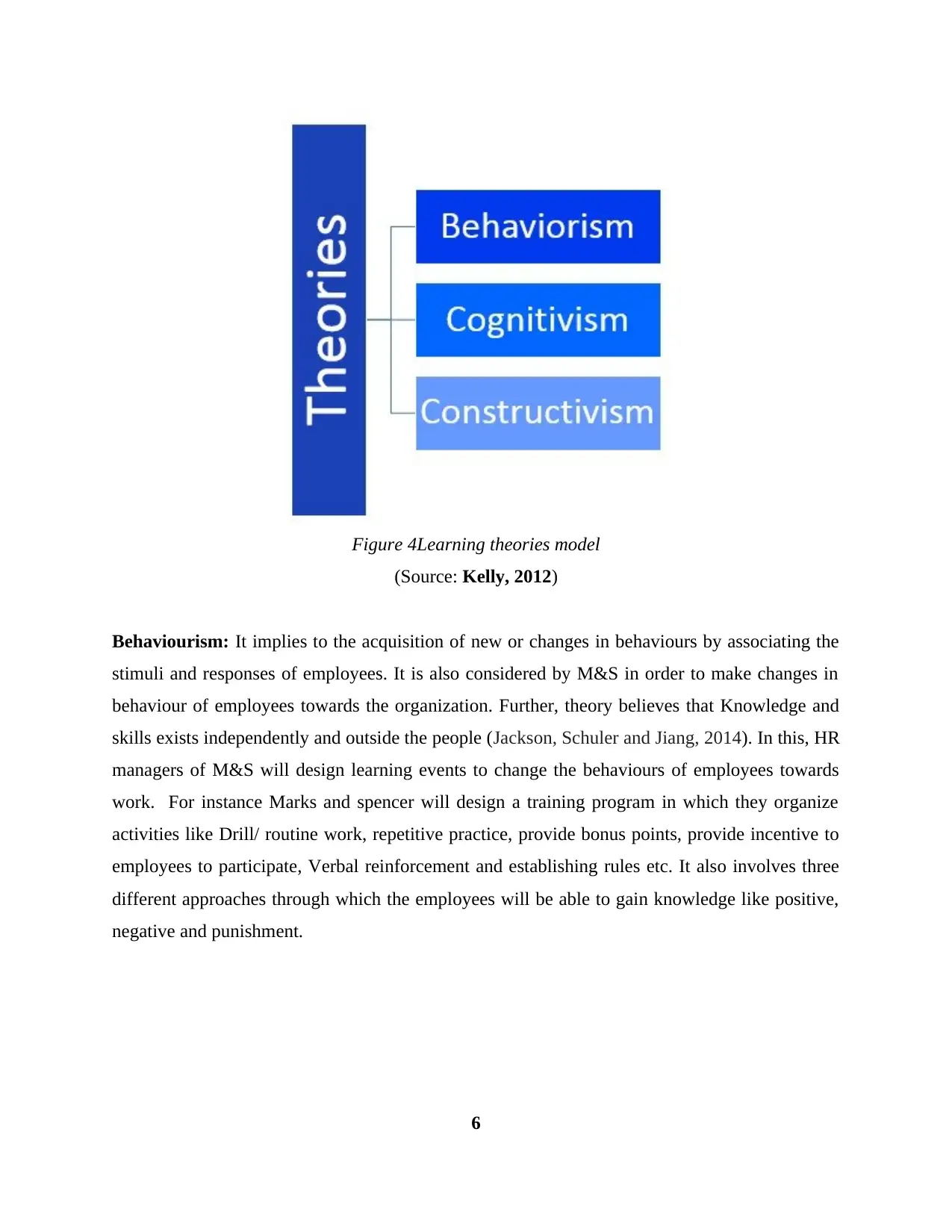
Figure 4Learning theories model
(Source: Kelly, 2012)
Behaviourism: It implies to the acquisition of new or changes in behaviours by associating the
stimuli and responses of employees. It is also considered by M&S in order to make changes in
behaviour of employees towards the organization. Further, theory believes that Knowledge and
skills exists independently and outside the people (Jackson, Schuler and Jiang, 2014). In this, HR
managers of M&S will design learning events to change the behaviours of employees towards
work. For instance Marks and spencer will design a training program in which they organize
activities like Drill/ routine work, repetitive practice, provide bonus points, provide incentive to
employees to participate, Verbal reinforcement and establishing rules etc. It also involves three
different approaches through which the employees will be able to gain knowledge like positive,
negative and punishment.
6
(Source: Kelly, 2012)
Behaviourism: It implies to the acquisition of new or changes in behaviours by associating the
stimuli and responses of employees. It is also considered by M&S in order to make changes in
behaviour of employees towards the organization. Further, theory believes that Knowledge and
skills exists independently and outside the people (Jackson, Schuler and Jiang, 2014). In this, HR
managers of M&S will design learning events to change the behaviours of employees towards
work. For instance Marks and spencer will design a training program in which they organize
activities like Drill/ routine work, repetitive practice, provide bonus points, provide incentive to
employees to participate, Verbal reinforcement and establishing rules etc. It also involves three
different approaches through which the employees will be able to gain knowledge like positive,
negative and punishment.
6
⊘ This is a preview!⊘
Do you want full access?
Subscribe today to unlock all pages.

Trusted by 1+ million students worldwide
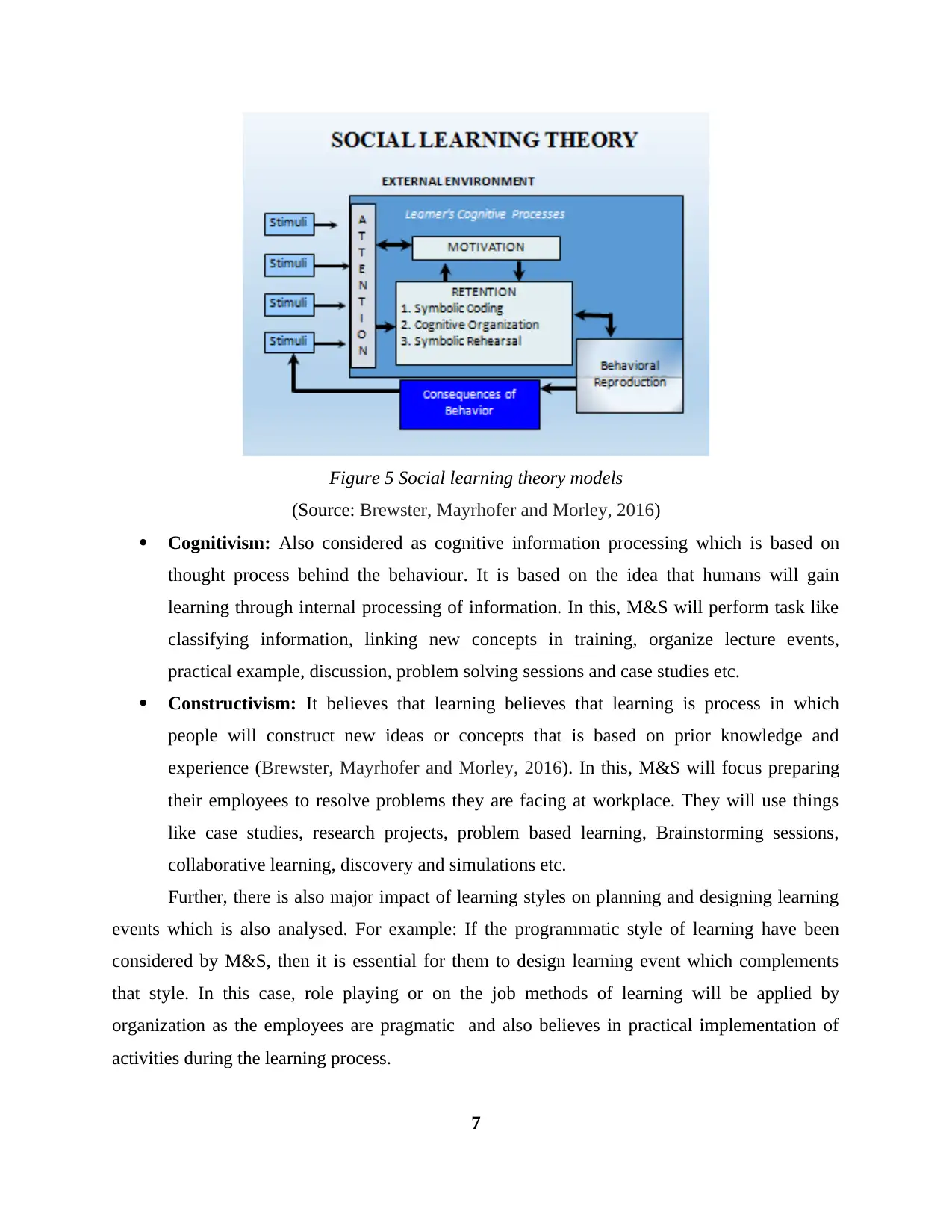
Figure 5 Social learning theory models
(Source: Brewster, Mayrhofer and Morley, 2016)
Cognitivism: Also considered as cognitive information processing which is based on
thought process behind the behaviour. It is based on the idea that humans will gain
learning through internal processing of information. In this, M&S will perform task like
classifying information, linking new concepts in training, organize lecture events,
practical example, discussion, problem solving sessions and case studies etc.
Constructivism: It believes that learning believes that learning is process in which
people will construct new ideas or concepts that is based on prior knowledge and
experience (Brewster, Mayrhofer and Morley, 2016). In this, M&S will focus preparing
their employees to resolve problems they are facing at workplace. They will use things
like case studies, research projects, problem based learning, Brainstorming sessions,
collaborative learning, discovery and simulations etc.
Further, there is also major impact of learning styles on planning and designing learning
events which is also analysed. For example: If the programmatic style of learning have been
considered by M&S, then it is essential for them to design learning event which complements
that style. In this case, role playing or on the job methods of learning will be applied by
organization as the employees are pragmatic and also believes in practical implementation of
activities during the learning process.
7
(Source: Brewster, Mayrhofer and Morley, 2016)
Cognitivism: Also considered as cognitive information processing which is based on
thought process behind the behaviour. It is based on the idea that humans will gain
learning through internal processing of information. In this, M&S will perform task like
classifying information, linking new concepts in training, organize lecture events,
practical example, discussion, problem solving sessions and case studies etc.
Constructivism: It believes that learning believes that learning is process in which
people will construct new ideas or concepts that is based on prior knowledge and
experience (Brewster, Mayrhofer and Morley, 2016). In this, M&S will focus preparing
their employees to resolve problems they are facing at workplace. They will use things
like case studies, research projects, problem based learning, Brainstorming sessions,
collaborative learning, discovery and simulations etc.
Further, there is also major impact of learning styles on planning and designing learning
events which is also analysed. For example: If the programmatic style of learning have been
considered by M&S, then it is essential for them to design learning event which complements
that style. In this case, role playing or on the job methods of learning will be applied by
organization as the employees are pragmatic and also believes in practical implementation of
activities during the learning process.
7
Paraphrase This Document
Need a fresh take? Get an instant paraphrase of this document with our AI Paraphraser
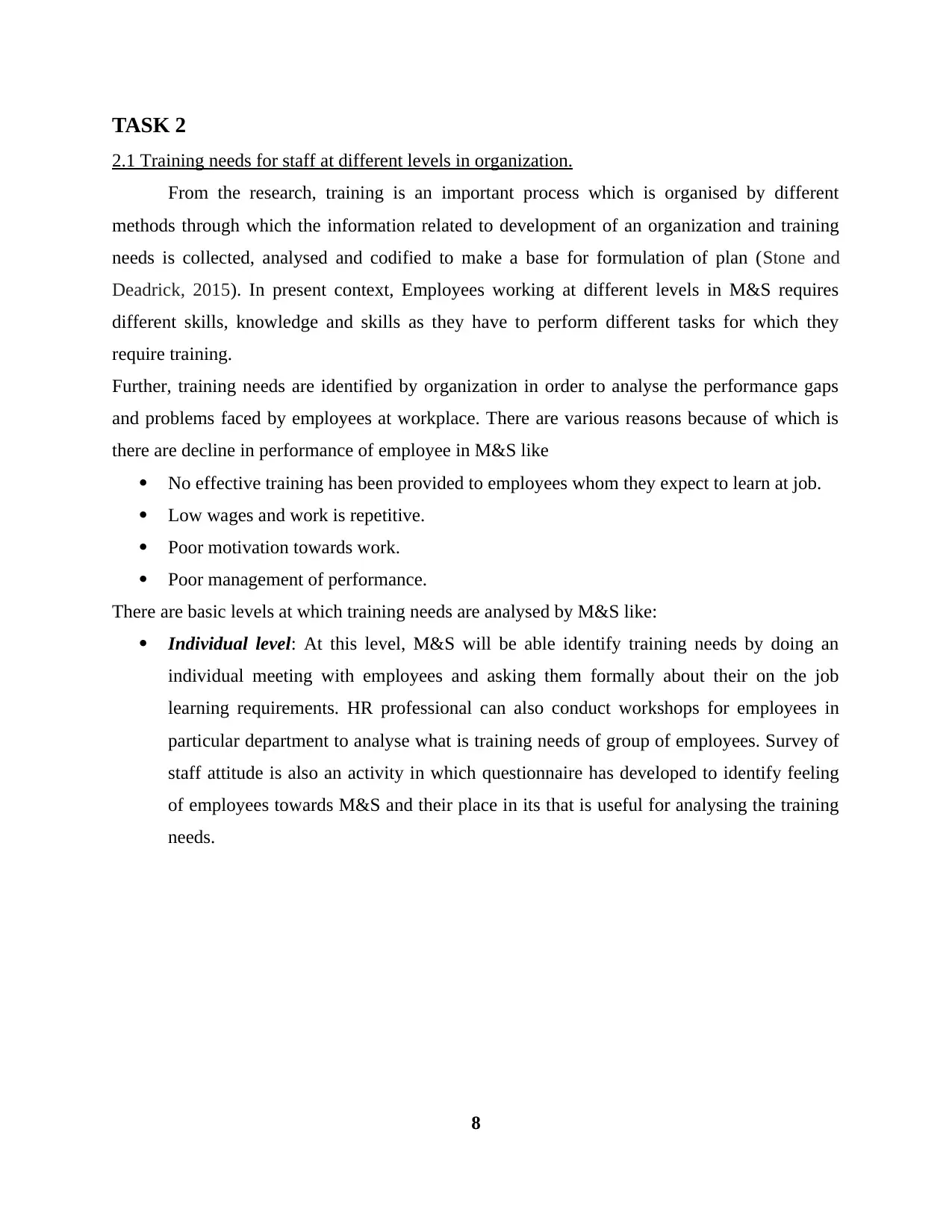
TASK 2
2.1 Training needs for staff at different levels in organization.
From the research, training is an important process which is organised by different
methods through which the information related to development of an organization and training
needs is collected, analysed and codified to make a base for formulation of plan (Stone and
Deadrick, 2015). In present context, Employees working at different levels in M&S requires
different skills, knowledge and skills as they have to perform different tasks for which they
require training.
Further, training needs are identified by organization in order to analyse the performance gaps
and problems faced by employees at workplace. There are various reasons because of which is
there are decline in performance of employee in M&S like
No effective training has been provided to employees whom they expect to learn at job.
Low wages and work is repetitive.
Poor motivation towards work.
Poor management of performance.
There are basic levels at which training needs are analysed by M&S like:
Individual level: At this level, M&S will be able identify training needs by doing an
individual meeting with employees and asking them formally about their on the job
learning requirements. HR professional can also conduct workshops for employees in
particular department to analyse what is training needs of group of employees. Survey of
staff attitude is also an activity in which questionnaire has developed to identify feeling
of employees towards M&S and their place in its that is useful for analysing the training
needs.
8
2.1 Training needs for staff at different levels in organization.
From the research, training is an important process which is organised by different
methods through which the information related to development of an organization and training
needs is collected, analysed and codified to make a base for formulation of plan (Stone and
Deadrick, 2015). In present context, Employees working at different levels in M&S requires
different skills, knowledge and skills as they have to perform different tasks for which they
require training.
Further, training needs are identified by organization in order to analyse the performance gaps
and problems faced by employees at workplace. There are various reasons because of which is
there are decline in performance of employee in M&S like
No effective training has been provided to employees whom they expect to learn at job.
Low wages and work is repetitive.
Poor motivation towards work.
Poor management of performance.
There are basic levels at which training needs are analysed by M&S like:
Individual level: At this level, M&S will be able identify training needs by doing an
individual meeting with employees and asking them formally about their on the job
learning requirements. HR professional can also conduct workshops for employees in
particular department to analyse what is training needs of group of employees. Survey of
staff attitude is also an activity in which questionnaire has developed to identify feeling
of employees towards M&S and their place in its that is useful for analysing the training
needs.
8
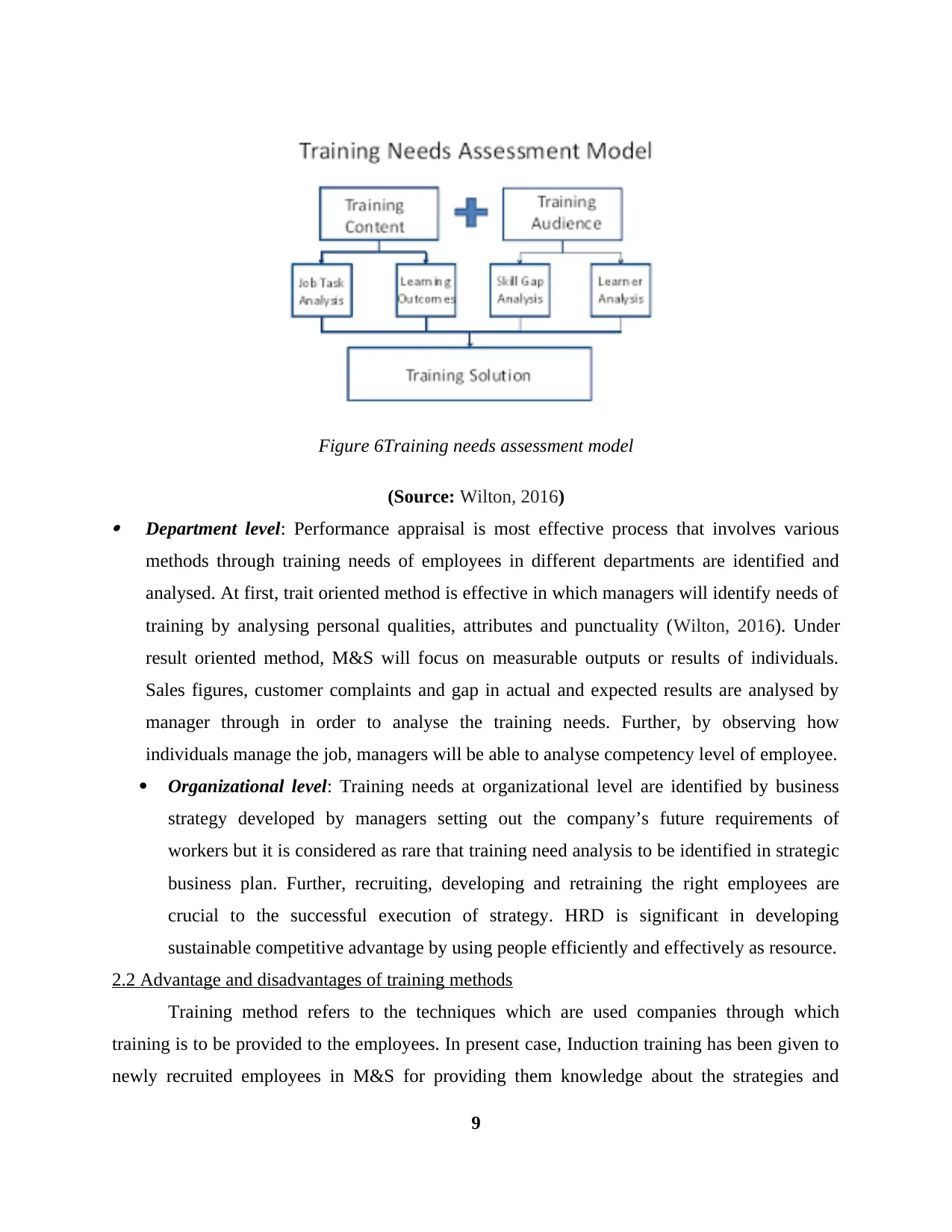
Figure 6Training needs assessment model
(Source: Wilton, 2016) Department level: Performance appraisal is most effective process that involves various
methods through training needs of employees in different departments are identified and
analysed. At first, trait oriented method is effective in which managers will identify needs of
training by analysing personal qualities, attributes and punctuality (Wilton, 2016). Under
result oriented method, M&S will focus on measurable outputs or results of individuals.
Sales figures, customer complaints and gap in actual and expected results are analysed by
manager through in order to analyse the training needs. Further, by observing how
individuals manage the job, managers will be able to analyse competency level of employee.
Organizational level: Training needs at organizational level are identified by business
strategy developed by managers setting out the company’s future requirements of
workers but it is considered as rare that training need analysis to be identified in strategic
business plan. Further, recruiting, developing and retraining the right employees are
crucial to the successful execution of strategy. HRD is significant in developing
sustainable competitive advantage by using people efficiently and effectively as resource.
2.2 Advantage and disadvantages of training methods
Training method refers to the techniques which are used companies through which
training is to be provided to the employees. In present case, Induction training has been given to
newly recruited employees in M&S for providing them knowledge about the strategies and
9
(Source: Wilton, 2016) Department level: Performance appraisal is most effective process that involves various
methods through training needs of employees in different departments are identified and
analysed. At first, trait oriented method is effective in which managers will identify needs of
training by analysing personal qualities, attributes and punctuality (Wilton, 2016). Under
result oriented method, M&S will focus on measurable outputs or results of individuals.
Sales figures, customer complaints and gap in actual and expected results are analysed by
manager through in order to analyse the training needs. Further, by observing how
individuals manage the job, managers will be able to analyse competency level of employee.
Organizational level: Training needs at organizational level are identified by business
strategy developed by managers setting out the company’s future requirements of
workers but it is considered as rare that training need analysis to be identified in strategic
business plan. Further, recruiting, developing and retraining the right employees are
crucial to the successful execution of strategy. HRD is significant in developing
sustainable competitive advantage by using people efficiently and effectively as resource.
2.2 Advantage and disadvantages of training methods
Training method refers to the techniques which are used companies through which
training is to be provided to the employees. In present case, Induction training has been given to
newly recruited employees in M&S for providing them knowledge about the strategies and
9
⊘ This is a preview!⊘
Do you want full access?
Subscribe today to unlock all pages.

Trusted by 1+ million students worldwide
1 out of 24
Related Documents
Your All-in-One AI-Powered Toolkit for Academic Success.
+13062052269
info@desklib.com
Available 24*7 on WhatsApp / Email
![[object Object]](/_next/static/media/star-bottom.7253800d.svg)
Unlock your academic potential
Copyright © 2020–2025 A2Z Services. All Rights Reserved. Developed and managed by ZUCOL.




